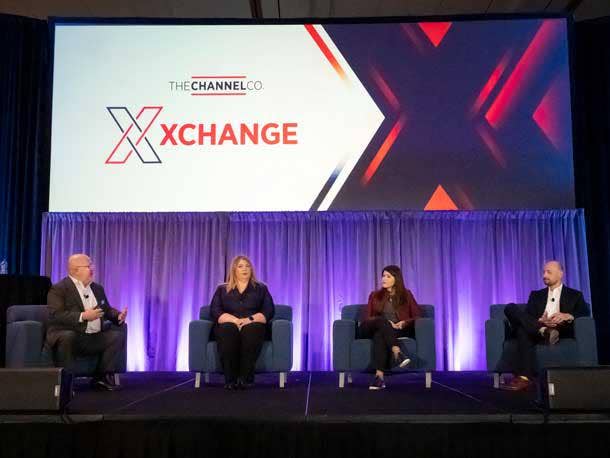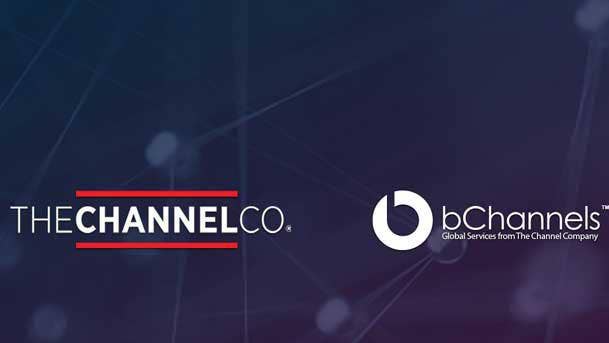State Of Partner Profitability Study: Services-Led Business Driving The Most Growth
The Channel Company CEO Blaine Raddon reveals the results of the State of Partner Profitability study and leads a discussion with a panel of solution provider executives around how they’ve changed their business models and where they see the most growth ahead.

State Of Partner Profitability Study
Solution providers are changing their business models to focus on new technologies and ways of doing business that can help them meet new challenges. That is a big conclusion of The Channel Company State of Partner Profitability 2021, based on a survey of channel partners conducted in 2021.
Blaine Raddon, CEO of The Channel Company, the parent of CRN and the XChange series of channel-focused events, Monday went on stage with three solution providers to discuss some of the findings of the State of Partner Profitability 2021 study and the kind of transformations they are making.
On the panel, from left to right in the photo, in addition to Raddon are Pamela Diaz, president and CEO of Entara, a Chicago-based XSP, or extended services provider; Dawn Sizer, co-founder and CEO of 3rd Element Consulting, a Mechanicsburg, Pa.-based MSP; and Brent Yax, CEO of Awecomm Technologies, a Troy, Mich.-based MSP.
Raddon also used his time on stage to talk about the transformations The Channel Company itself is going through to be a bigger voice for the channel, including an acquisition making the company a global channel force as well as a new diversity equity and inclusion initiative.
Read on to learn more about where this dynamic industry is heading.

Solution Providers Shift From Product-Led To More Profitable Services-Led Business
The Channel Company’s State of Partner Profitability 2021 study found that solution providers have shifted from a product-led business model to one that blends product and services sales, with some having shifted to a complete services-led business model, Raddon said.
Security is the most profitable solution that solution providers offer today, according to the study, followed by systems and network management, disaster recovery and business continuity, application integration and middleware, network design and architecture, application customization and development, and business intelligence and analytics.
When Raddon asked how the panelists’ businesses have changed recently, Sizer responded that there have been supply chain issues that resulted from the COVID-19 pandemic.
“It doesn’t matter what type of stuff that it was, we couldn’t get any of it,” she said. “So yes, we’ve moved heavily into services at this point because that’s what we can sell. Not that we were selling a ton of products previously, but when that’s all you have you are looking at, ‘OK, so where do we stand and what other things can I do? What can I become a resident expert in?”
Yax said that a product-led business model leads to a drive to the bottom as businesses chase the better price.
“What happens there is the expertise is kind of left to the customer,” he said. “They’re telling you what they want,” he said. “But when you’re pushing heavy into the services side, what we found was that we wanted to be that intelligence. We wanted to be that expertise. So instead of them making a decision and telling us what we need to provide them, we wanted them to come to us and say, ‘What decisions should we be making? What should we be buying?’ ... And it became more of a business discussion instead of a product discussion.”
Diaz said that Entara, with its focus on financial institutions, pivoted during COVID to areas such as breach remediation. For Entara, lockdowns from the pandemic caused a lot of customers to want to cancel contracts, which impacted the company as it had a lot of on-site services engineers.
“We let our clients out of contracts,” she said. “That was the right thing to do, but it was impactful to our business. So we went back to, ‘What else can we do as far as revenue?’ So we started working with partners about how to bring breached clients back up. And that builds tremendous trust. So now we are seeing pull-through, not only on the project side, but then also on our recurring revenue side.”

Profit And Growth Drivers
According to the Partner Profitability Study, MSPs received 28 percent of revenue via resale of services, 43 percent via partner-managed services, and 29 percent via partner-owned and managed services, Raddon said. However, the partner-owned and managed services had the greatest gross margins at 59 percent followed by 37 percent for partner-managed services and only 22.5 percent for resale, he said.
When Raddon asked the panelists what is driving their growth and profitability, Sizer responded that it all comes down to the trust level her company has with customers.
“For us, we start a project with them and create that trust and then that project leads into something else, and that leads into something else,” she said. “We were just a small MSP a couple of years ago, and now all of a sudden we’re doing all these other things because we started with a small project that led to a trust relationship that then led to a co-managed relationship in one organization that is in four different states with multiple offices.”
For Awecomm Technologies, the challenge in creating value and profit margin was that as more and more companies offer services, competition increases and price falls, Yax said.
“So what we tried to do is package our services where we could just go after the overall IT budgets and not just fight for services,” he said. “So our sales cycle is very long. Unfortunately, it sometimes takes a year or two years because we have to continue to build trust and build trust and build trust with that person before they ever want to work with us. [And over time] they allow us to provide what we consider our best practices.”
Aiming for the IT budget is definitely an important way to drive growth, Sizer said.
“When you have that budget, that allows you as the MSP to not sell a product,” she said. “It allows you to push the products out of there because now you’re controlling what the budget actually is. And the client isn’t necessarily driving, ‘I want this Product A, Product B and Product C.’ We’re like, ‘OK, well we’re going to sell you these particular things because you have the budget to do it.’ This changes the conversation.”

Shift To Security Specialization
Raddon said that solution providers in the past used to be specialized in things like Microsoft or IBM, but more recently have become known as networking VARs, networking service providers, storage service providers and so on. Now, he said, the pendulum may be swinging back to specialization, particularly in the security business, which led to the question of how much security is impacting solution providers’ business.
It can be a double-edged sword, Yax said.
“When you create that abstraction, you also simplify things that may not need simplifying,” he said. “Security is one of those things where it is very complex, and providing an environment for our customers where they’re more secure takes a lot of time, energy, effort and expertise. They’re not cheap individuals. So yes, it’s tough for us. It has probably impacted us on a negative almost because of how we package our services and how we provide them. We sign a full-year contract for the IT budget and we say, ‘This is where we’re going to be at in a year.’ And if something comes in—all of a sudden there’s a new threat or a new style of phishing—we start doing training and training. But it’s a good thing because there’s awareness out there.”
Knowing where to start the conversation sometimes is really difficult, Diaz said. “Where’s the client at now because you have to meet them where they are. Are they already at that level where you can speak as a peer? And a lot of times you’re not. And I think we assume that people are at a certain level and they’re not, so we’re starting from the ground up having to educate. And it takes time to get them educated enough so they don’t feel like they’re not in that trusted relationship.”

What Do SMBs Want?
Raddon said solution providers can approach SMB customers from anywhere in the spectrum of selling only products to being focused exclusively on services the partners build themselves, and he asked the panelists where they fit on that continuum.
Diaz said her company seldom resells something but instead wants to build an entire stack for its customers, which may include letting someone else sell a product as long as Entara has the managed component part.
“You just have a conversation about what you’re offering to your client and the value they’re going to see. A lot of them won’t see it because they don’t understand IT in a way that a lot of people in the room would. But it’s the educational piece and letting them understand why you’re doing these specific products and that you’ll give them that one throat to choke, if you will, so that they can come to you for anything and you’ll be managing that.”
Sizer said there is a big education component in delivering the value of an MSP’s stack to SMBs, particularly in showing them what will be accomplished for them and not focusing on the different elements of the solution.
“We tell them you’re going to get the 3rd Element stack, and here are the objectives that it accomplishes, and here’s why we’re doing what we’re doing, and these are the things that we are fixing by using this particular thing, or preventing against, or reducing your risk, whatever that conversation needs to be,” she said.
As a solution provider goes more on the continuum to owning more of the services they provide, the rewards grow—as do the risks, Yax said.
“When we were smaller, the sales team would be super excited to sign a hundred-person organization, but we realized that we now need to deploy 100 assets into that organization. We had to finance it somehow. And our contracts are built so that they’re paying us over four years for that hardware we pay for on day one. ... So the rewards are there. It’s just, how do you finance it if somebody walks away or if somebody breaks the contract?”
When it comes to fully managed services, the only way it works is to stop letting customers make decisions, Yax said.
“A lot of times you tell them this is what they’ll need, and they don’t believe you’re on their budget for it,” he said. “So we thought the biggest risk would be if we don’t actually get to control how it’s done. So the way we did our services was to stop that from happening so that we make all the decisions and we can have conversations about the outcome. And we can protect ourselves that way from failure.”

Big Changes At The Channel Company
Digital marketing has become an important way to communicate with channel partners and customers, and The Channel Company last week expanded its capabilities with the acquisition of global technology marketing agency bChannels, Raddon said.
“They’re in this digital marketing space, and they do this worldwide,” he said. “So we’re taking our act on the road and starting to take advantage of doing this in other geographies. We’re still going to be completely focused on the U.S. and on these events in the U.S., but it gives us an opportunity to feed the engine that supports you guys, both editorially and with these events. ... We wanted to make sure that you guys understand that we’re healthy and growing.”
Raddon also introduced a new initiative for The Channel Company called the Inclusive Leadership Network. The Inclusive Leadership Network will be a community similar to The Channel Company’s Women of the Channel Leadership Network, but with a focus on diversity, equity and inclusion. Raddon said it will be run by Cass McMann, who recently joined The Channel Company as DEI community leader. “She’s waking up every day, going to sleep late at night, thinking about how we put together this community,” he said.
The focus of the Inclusive Leadership Network is on bringing together people who want to talk about diversity in the channel, Raddon said. “It’s about belonging,” he said. “That’s the main thing that she’s brought to this. Everybody’s welcome. It’s about sharing best practices, about educating both at the individual level and at the company level. And I would tell you, as we’ve talked to sponsors and vendors, the excitement level to have a community that they can be a part of, that they can sponsor, to go along with each of their individual efforts in the space is tremendous.”